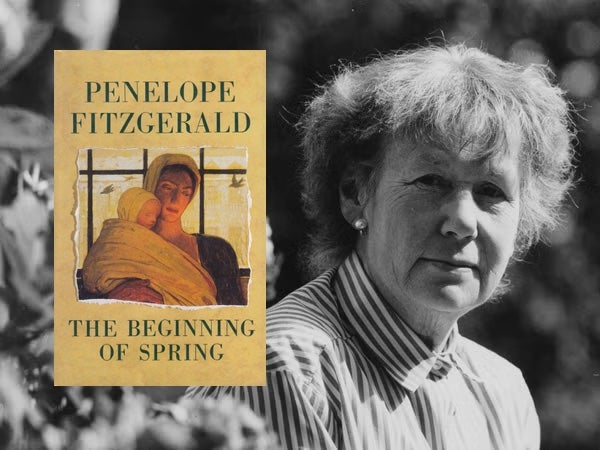Book of a lifetime: The Beginning of Spring by Penelope Fitzgerald
From The Independent archive: Katharine McMahon revisits a Russian doll of a novel, where the history of Moscow and England is effortlessly woven with individual lives and nobody is as they seem

When I was quite a new writer, my editor gave me a copy of The Beginning of Spring. I sat in the Underground aglow with pleasure; the book felt like a talisman, writing to which I should aspire.
As a child, I studied the covers of my favourite books, critical if they didn’t live up to the contents. The cover of The Beginning of Spring is stunning and mysterious – a serene portrait of mother and tightly swaddled infant, and a background of flowers, the lattice of a window and possibly something else, indefinable. The colours are deep golds, reds and yellows.
The detail is from an English picture by Frederick Cayley Robinson, and a photograph of St Basil’s Cathedral, Moscow. Try as I might, I cannot make out the cathedral. And this enigmatic cover sums up the entire book, which is so spare yet so dense that though you re-read and re-read, you cannot comprehend everything that’s there.
So much is about what’s not on the page. It’s a Russian doll of a novel, except that the layers just go on unpeeling. On one level you’re reading a story about Nellie, the wife of an English printer living in Moscow, who packs her bags and returns to England without a word to anyone.
On another, you are living the history of Moscow and England at that moment – the early spring of 1913. On yet another, the reader is treated to character sketches that reveal the obsessive, wayward lives of the people who surround the wifeless printer, Frank, and his three young children. Nobody is as they seem.
Frank’s manager, Selwyn, has written a collection of poetry. “Birch Tree Thoughts was at the censor now, and since all poetry was suspect, would perhaps be more carefully read there than it ever would again.” Such understatement, such evocation of momentous political activity buried in a little joke at the expense of Selwyn, is typical.
Nor does Fitzgerald pull her punches; penetrating the affection and warmth are moments of shocking violence. The Beginning of Spring reveals a world that’s shifting, like the ice that permeates the book, until, towards the end, it begins to disintegrate and thaw.
But above all the novel is a cracking read. Why has Nellie left her husband, and will she come back? We care because we share Frank’s bewilderment as he runs his press and his household, determined to be decent and deserving of the absent Nellie, but wrong-footed by students, employees, nursemaids and colleagues, each with their own agenda. This is effortless, poetic writing that breaks rules.
To me, the book is the essence of why I love novels and wanted to be a writer. I am drawn deep into another world and emerge stronger, happier, surer that humankind is full of wonder and mystery as well as despair, treachery and foolishness. Which reminds me – the last page quite simply takes my breath away.



Join our commenting forum
Join thought-provoking conversations, follow other Independent readers and see their replies
Comments